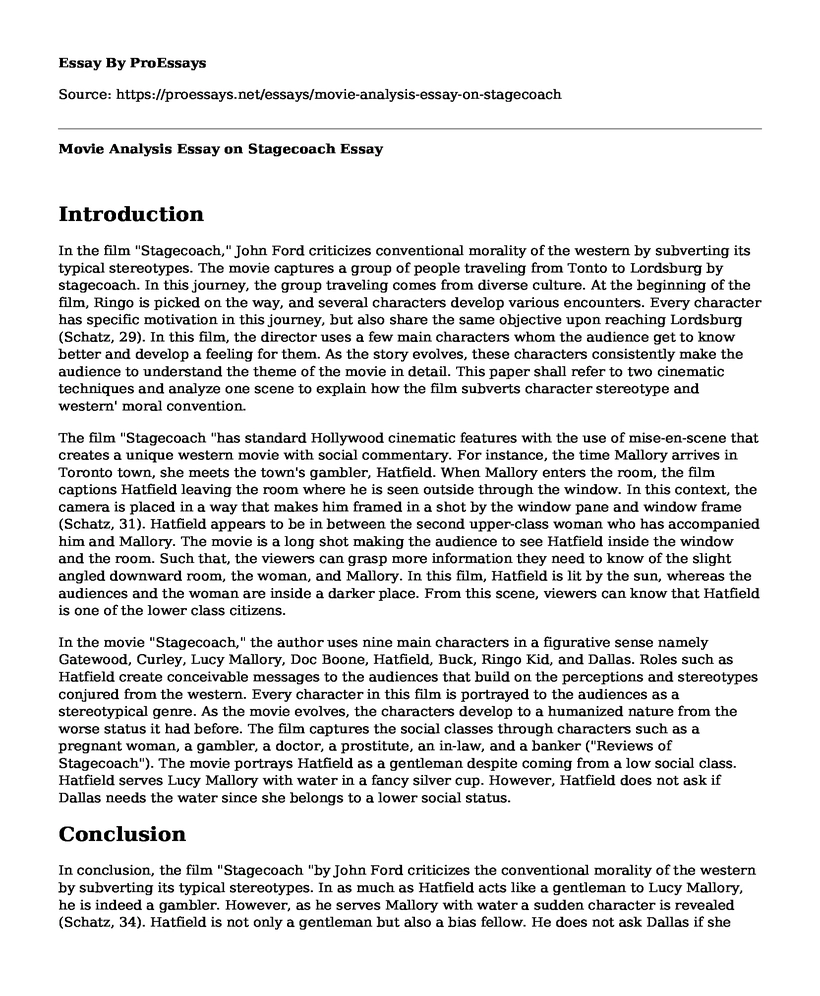Introduction
In the film "Stagecoach," John Ford criticizes conventional morality of the western by subverting its typical stereotypes. The movie captures a group of people traveling from Tonto to Lordsburg by stagecoach. In this journey, the group traveling comes from diverse culture. At the beginning of the film, Ringo is picked on the way, and several characters develop various encounters. Every character has specific motivation in this journey, but also share the same objective upon reaching Lordsburg (Schatz, 29). In this film, the director uses a few main characters whom the audience get to know better and develop a feeling for them. As the story evolves, these characters consistently make the audience to understand the theme of the movie in detail. This paper shall refer to two cinematic techniques and analyze one scene to explain how the film subverts character stereotype and western' moral convention.
The film "Stagecoach "has standard Hollywood cinematic features with the use of mise-en-scene that creates a unique western movie with social commentary. For instance, the time Mallory arrives in Toronto town, she meets the town's gambler, Hatfield. When Mallory enters the room, the film captions Hatfield leaving the room where he is seen outside through the window. In this context, the camera is placed in a way that makes him framed in a shot by the window pane and window frame (Schatz, 31). Hatfield appears to be in between the second upper-class woman who has accompanied him and Mallory. The movie is a long shot making the audience to see Hatfield inside the window and the room. Such that, the viewers can grasp more information they need to know of the slight angled downward room, the woman, and Mallory. In this film, Hatfield is lit by the sun, whereas the audiences and the woman are inside a darker place. From this scene, viewers can know that Hatfield is one of the lower class citizens.
In the movie "Stagecoach," the author uses nine main characters in a figurative sense namely Gatewood, Curley, Lucy Mallory, Doc Boone, Hatfield, Buck, Ringo Kid, and Dallas. Roles such as Hatfield create conceivable messages to the audiences that build on the perceptions and stereotypes conjured from the western. Every character in this film is portrayed to the audiences as a stereotypical genre. As the movie evolves, the characters develop to a humanized nature from the worse status it had before. The film captures the social classes through characters such as a pregnant woman, a gambler, a doctor, a prostitute, an in-law, and a banker ("Reviews of Stagecoach"). The movie portrays Hatfield as a gentleman despite coming from a low social class. Hatfield serves Lucy Mallory with water in a fancy silver cup. However, Hatfield does not ask if Dallas needs the water since she belongs to a lower social status.
Conclusion
In conclusion, the film "Stagecoach "by John Ford criticizes the conventional morality of the western by subverting its typical stereotypes. In as much as Hatfield acts like a gentleman to Lucy Mallory, he is indeed a gambler. However, as he serves Mallory with water a sudden character is revealed (Schatz, 34). Hatfield is not only a gentleman but also a bias fellow. He does not ask Dallas if she needs water but instead ignores her based on the fact that she is from a lower social class. As the movie evolves, the audience is briefed on the remorse expression Mallory towards Dallas as a form of a flashback.
Works Cited
"Reviews of Stagecoach." John Ford'sStagecoach, pp. 179-184, DOI:10.1017/cbo9780511615269.008.
Schatz, T. "Stagecoach and Hollywood's A-Western Renaissance." John Ford'sStagecoach, pp. 21-47, DOI:10.1017/cbo9780511615269.002.
Cite this page
Movie Analysis Essay on Stagecoach. (2023, Mar 07). Retrieved from https://proessays.net/essays/movie-analysis-essay-on-stagecoach
If you are the original author of this essay and no longer wish to have it published on the ProEssays website, please click below to request its removal:
- Critical Essay on One Flew Over the Cuckoo's Nest
- Movie Analysis Essay on Life of Pi: A Journey of Belief, Discovery and Devotion
- Essay on Playwrights and Filmmakers: Enhancing Deeper Understanding With Styles
- Movie Analysis Essay on Bram Stoker's Dracula
- Essay Sample on White Rappers: Guests in the House of Hip-Hop
- Songs Reflect, Depict and Impact Los Angeles - Essay Sample
- Free Report Example on Striking Effect







